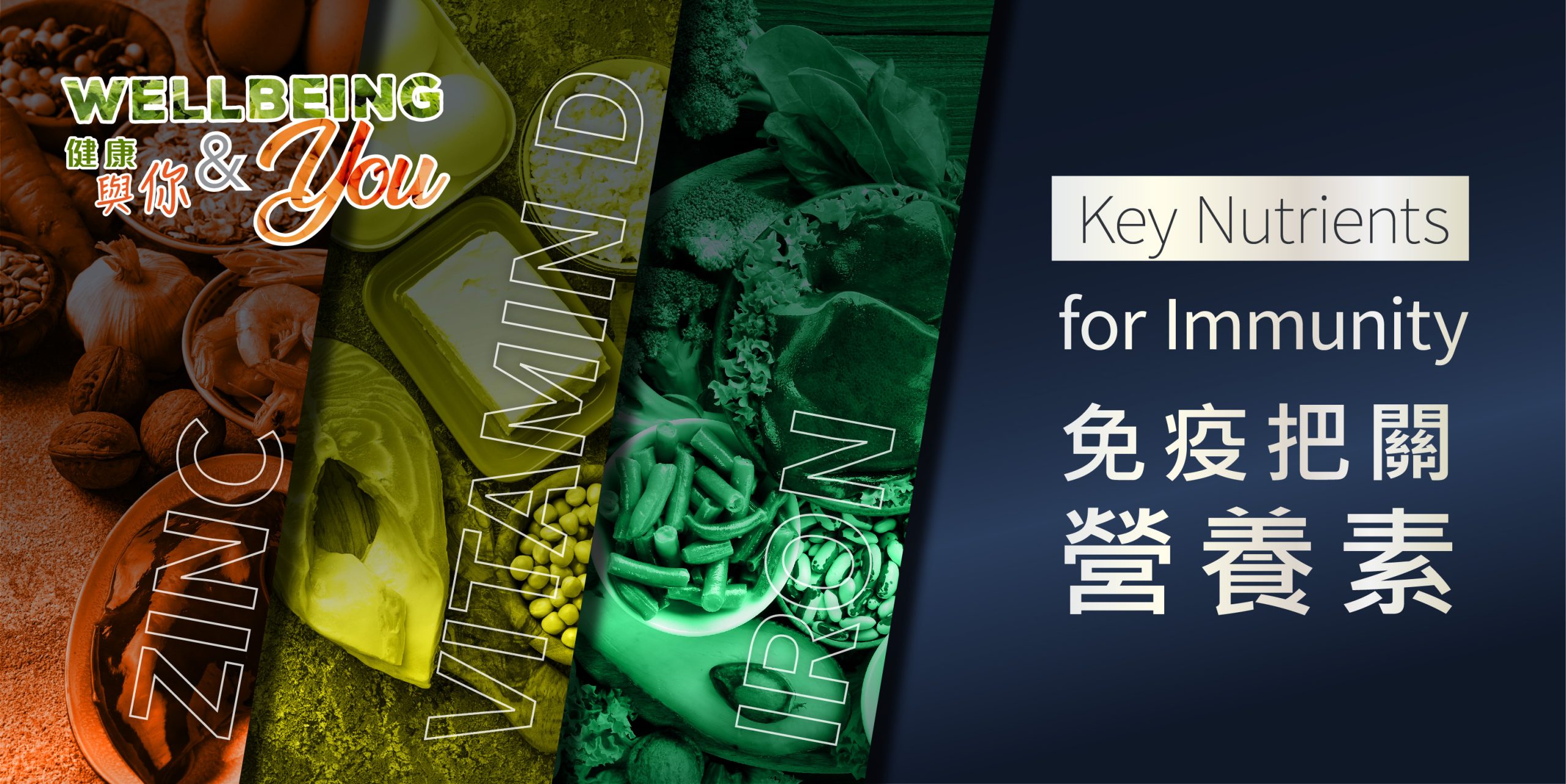[Wellbeing & You] Key Nutrients for Immunity

In the previous article, we discussed how vitamins A, C and E serve as antioxidants critical to “ACE”ing our inner defense game. This time, let us learn more about vitamin D, zinc and iron which are also essential to the normal functioning of our immune system!
Vitamin D
Vitamin D is a fat-soluble vitamin responsible for maintaining bone health by facilitating calcium absorption and regulating calcium and phosphate levels in blood. It also contributes to the homeostasis of our immune system.
Vitamin D deficiency
According to local observational studies, inadequate intake and hence deficiency of vitamin D were highly prevalent across age groups from preschool to elderly. Such deficiency may pose risks to developing rickets in children, osteomalacia in adults, and may also compromise normal immune functions.
How much vitamin D do we need per day?
| Life stage | Recommended intake (μg/d) |
| 1 to 64 years old | 10 |
| 65 years old and above | 15 |
| Pregnant (1st trimester) | 10 |
| Pregnant (2nd trimester) | 10 |
| Pregnant (3rd trimester) | 10 |
| Lactating | 10 |
Sources of vitamin D
- Sunlight. Most of the vitamin D in our body is formed when the skin is exposed to sunlight. To maintain sufficient vitamin D storage, make sure to go outdoor and expose your hands, face and arms for 5 to 15 minutes at least two to three times a week during summer and longer during winter!
- Food. A small amount of vitamin D comes from natural food sources and fortified food sources, which include:
- Natural sources: fatty fish (e.g. salmon, sardines, tuna), egg yolk, red meat, and liver
- Fortified sources: breakfast cereals, some dairy and plant milk products
Nutrition tips
- What if you are quarantine or finding difficulty squeezing time to go outdoor? Improvise and adapt! Take a short break from your room or balcony when the sun is high up, make sure to have the windows wide open to let the UV reach your skin!
Zinc
Zinc is an essential mineral that is critical to the formation of cells, enzymes, growth hormones and DNA. It also helps to heal damaged tissues and support a healthy immune system.
Zinc deficiency
Since zinc is required to support the growth and normal functioning of our immune system, even a mild deficiency may hinder our inner defense against viruses and bacteria due to the reduced activities by different immune cell types.
How much zinc do we need per day?
| Life stage | Recommended intake (mg/d) | |
| Male | Female | |
| 1 to 3 years old | 4.0 | 4.0 |
| 4 to 6 years old | 5.5 | 5.5 |
| 7 to 10 years old | 7.0 | 7.0 |
| 11 to 13 years old | 10.0 | 9.0 |
| 14 to 17 years old | 12.0 | 8.5 |
| 18 years old and above | 12.5 | 7.5 |
| Pregnant (1st trimester) | / | 9.5 |
| Pregnant (2nd trimester) | / | 9.5 |
| Pregnant (3rd trimester) | / | 9.5 |
| Lactating | / | 12 |
Sources of zinc
- Animal food sources are generally rich in zinc, which include:
- Shellfish e.g. oysters, crab, lobster
- Beef
- Poultry
- Pork
- Some plant food sources provide a decent amount of zinc, however, have a lower bioavailability (i.e. absorbed less effectively by the body) as compared to animal sources, examples include:
- Legumes
- Nuts and seeds
- Whole grains
- Fortified breakfast cereals
Nutrition Tips
- Phytate in plant foods inhibits zinc absorption and hence reduces its bioavailability. Food processing methods such as fermentation, soaking and heating helps to minimize such effect and improve zinc absorption.
Iron
Iron is an essential element for red blood cell production and also oxygen transportation to various body tissues.
Iron deficiency
Inadequate iron intake leads to insufficient red blood cell production, hence, iron deficiency anaemia. Symptoms include dizziness, poor appetite and also a weakened immune system.
How much iron do we need per day?
| Life stage | Recommended intake (mg/d) | |
| Male | Female | |
| 1 to 3 years old | 9 | 9 |
| 4 to 6 years old | 10 | 10 |
| 7 to 10 years old | 13 | 13 |
| 11 to 13 years old | 15 | 18 |
| 14 to 17 years old | 16 | 18 |
| 18 years old and above | 12 | 20 |
| Pregnant (1st trimester) | / | 20 |
| Pregnant (2nd trimester) | / | 24 |
| Pregnant (3rd trimester) | / | 29 |
| Lactating | / | 24 |
Sources of iron
Dietary iron exists in two forms. Heme ironis the better absorbed form which can only be found in animal sources. Non-heme iron can be found in plant foods, animal foods and fortified foods.
- Animal sources include:
- Shellfish e.g. oyster, shrimp, clam, etc.
- Red meat e.g. beef, pork, lamb, etc.
- Eggs
- Plant sources include:
- Spinach
- Wood ear fungus
- Soy products
- Red kidney beans
- Dried fruits
- Nuts and seeds
- Whole grains
Nutrition Tips
- Vitamin C enhances the absorption of non-heme iron. Try pairing iron sources with vitamin C rich foods e.g. tomato and kiwi fruits.
- Tea and coffee hinders iron absorption. Consume these drinks between meals instead of during mealtime.

Reference: Student Health Service, Chinese Nutrition Society, Harvard School of Public Health, Yip PS, et al, Wang EWL, et al, Chen J, et al, Saunders AV, et al

